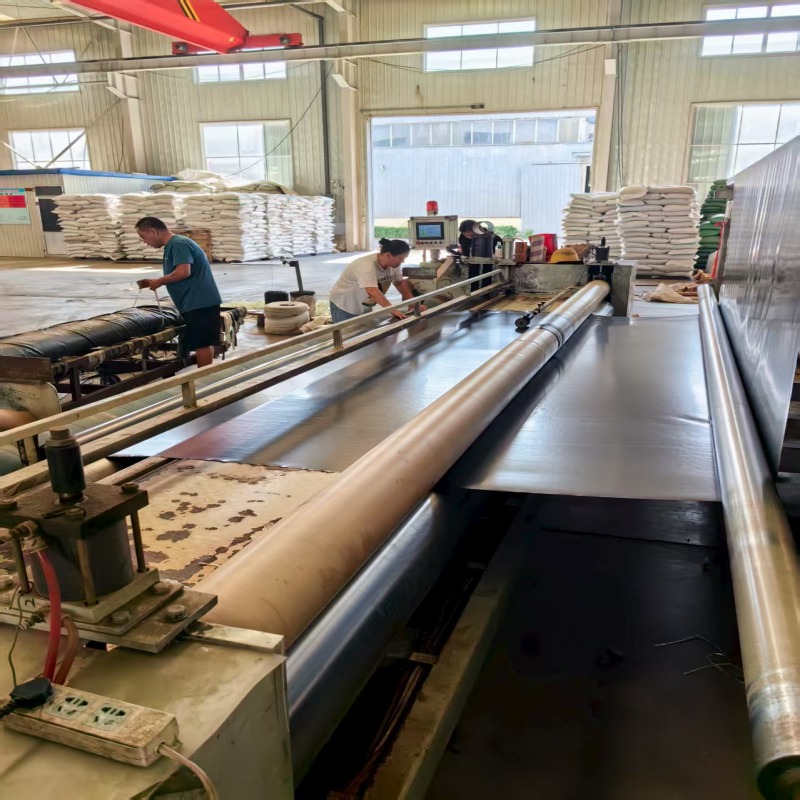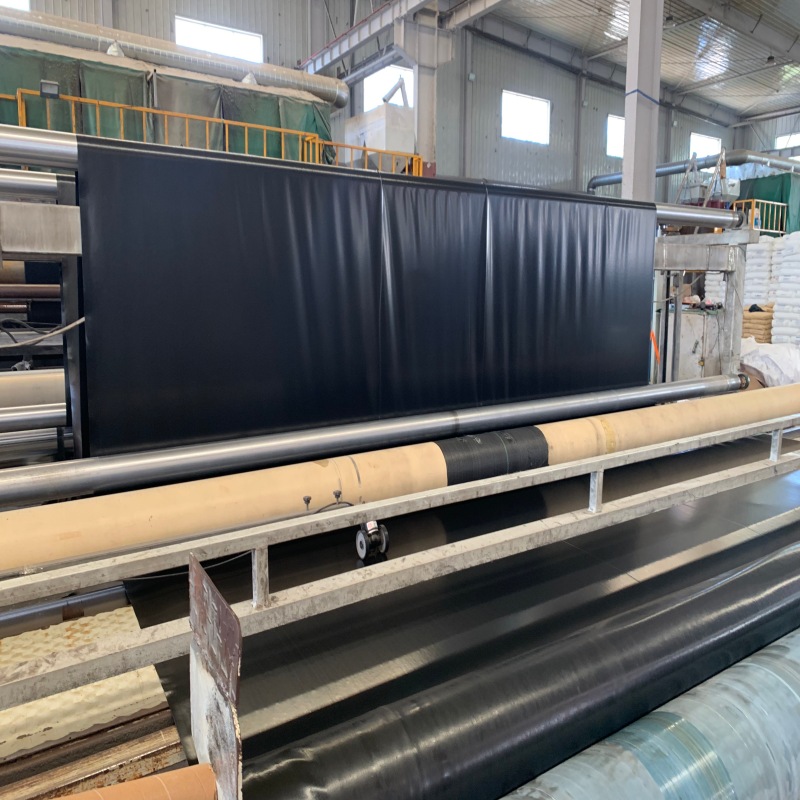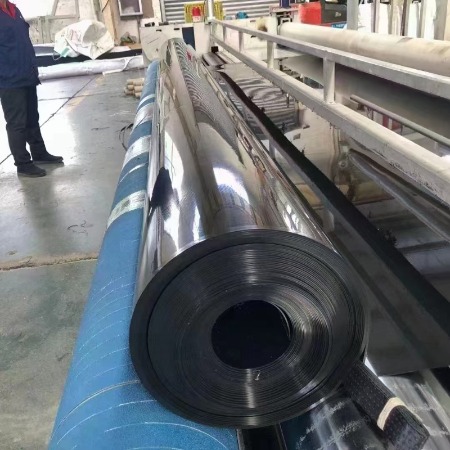هاتف : +86 -18005440164
هاتف : +86 -15621270096
Whatsapp : +86 -18005440164
Whatsapp : +86 -15621270096
بريد إلكتروني : luna@nuokungeo.com
بريد إلكتروني : jone@nuokungeo.com
المواد الجيوسينثتية هي مواد هندسية تُستخدم في الهندسة المدنية والبيئية والجيوتقنية، وتشمل أغشية البولي إيثيلين عالي الكثافة (HDPE) وبطانات البولي إيثيلين الخطية منخفضة الكثافة (LLDPE) والمنسوجات الأرضية والشبكات الأرضية. تختلف عمليات تصنيعها باختلاف نوع المادة والوظيفة المطلوبة. فيما يلي تفاصيل عمليات إنتاج المواد الجيوسينثتية الرئيسية.
الأغشية الجيوممبرينية (HDPE، LLDPE، والمركبات)
الأغشية الجيوممبرينية هي حواجز مضادة للتسرب مصنوعة من البوليمرات مثل البولي إيثيلين عالي الكثافة (HDPE) والبولي إيثيلين الخطي منخفض الكثافة (LLDPE).
مواد خام:
الراتنج الأساسي (على سبيل المثال، حبيبات البولي إيثيلين عالي الكثافة/البولي إيثيلين منخفض الكثافة البكر)
المواد المضافة:
الكربون الأسود (2-3% للحماية من الأشعة فوق البنفسجية)، ومضادات الأكسدة، والمثبتات.
طريقة الإنتاج:
النفخ بالقولبة (ينطبق على البولي إيثيلين الخطي منخفض الكثافة (LLDPE) والبولي إيثيلين الناعم البولي إيثيلين عالي الكثافة (HDPE)):يتم ضغط الراتينج المذاب في أنبوب، ثم نفخه في فيلم، ثم تبريده وتسويته في شكل ورقة.
المميزات: إنتاج أفلام موحدة، ثنائية المحور، ومقاومة للتمزق.
التقويم (للبولي إيثيلين السميك عالي الكثافة (HDPE)):يتم ضغط البوليمر المنصهر بين بكرات ساخنة في شكل ورقة (سمكها 0.5-3.0 ملم).
المزايا: التحكم الدقيق في السُمك، مثالي لبطانات مكبات النفايات (على سبيل المثال، الأغشية الجيوممبرانية المصنوعة من مادة البولي إيثيلين عالي الكثافة بسمك 2 مم).
الملمس (أنواع GMST/GMT):
إن العمليات المنقوشة أو المبثوقة بشكل مشترك تخلق سطحًا مخططًا/مُحَلَّطًا، مما يعزز احتكاك المنحدر (زاوية الاحتكاك 25-35 درجة).
ضبط الجودة:
الاختبارات: قوة الشد (HDPE ≥ 25 ميجا باسكال)، الاستطالة (LLDPE ≥ 700٪)، والنفاذية (≤ 1 × 10⁻¹³ سم / ثانية).
الشهادات: GRI GM13، ASTM D6693، و ISO 9001.
 |  |  |
الجيوتكستايل (المنسوجة وغير المنسوجة)
المنسوجات الجيوتقنية هي أقمشة نفاذة تستخدم للترشيح أو الصرف أو التعزيز.
مادة:
ألياف البولي بروبيلين (PP) أو البوليستر (PET).
عملية التصنيع:
الجيوتكستايل غير المنسوجة:
يتم وضع الألياف بشكل عشوائي وربطها عن طريق ثقب الإبرة أو الترابط بالذوبان الساخن (على سبيل المثال، 300 جرام / م 2 من مادة PET الجيوتكسيلية).
التطبيقات:طبقات الصرف الصحي للمكبات وحماية الجذور.
الجيوتكستايل المنسوجة:
يتم نسج الألياف في نمط شبكي (على سبيل المثال، بقوة شد تبلغ 80 كيلو نيوتن/متر لتقوية الطرق).
الخصائص الرئيسية:مقاومة للثقب، ونفاذية (5-15 لتر/م²/ثانية)، وثبات الأشعة فوق البنفسجية.
شبكات الجيوجريد والجيونيتس (التعزيز والصرف)
الشبكات الجيولوجية:مصنوعة من صفائح البولي إيثيلين عالية الكثافة المبثوقة، والتي يتم تمديدها بعد ذلك لإنشاء المسام والتشابك مع التربة. تستخدم للجدران الاستنادية وأسِرّة الطرق.
شبكات جيونيتس:هياكل بوليمرية ثلاثية الأبعاد مبثوقة تستخدم لتصريف المياه في مكبات النفايات والمنحدرات.
بطانة الطين الجيوسينثيتيكية (GCL)
بناء:يتم وضع البنتونيت بين طبقتين من الجيوتكستايل، ويتم ثقبه بالإبر لمزيد من الاستقرار.
يظهر خصائص الشفاء الذاتي عند ترطيبه.
المواد الجيوسينثتية المتخصصة
قماش خرساني:نسيج مشبع بمزيج خرساني جاف يتصلب عند الترطيب.
الأنابيب الجيولوجية/الأكياس الجيولوجية:أنابيب البولي بروبلين المنسوجة المملوءة بالتربة/الطين للتحكم في التآكل.
تُصنع الأغشية الجيوسنتثية من خلال عمليات مثل البثق والنسيج والصقل والترابط المركب، وهي مناسبة لتطبيقات مثل بطانات مكبات النفايات، وتثبيت المنحدرات، وأنظمة الصرف. ولا يزال التطور في الأغشية الجيوسنتثية المزخرفة والبطانات الذكية (المُزودة بأجهزة استشعار مدمجة) يُسهم في دفع عجلة الابتكار.
ترك رسالة
Scan to Wechat/Whatsapp :

